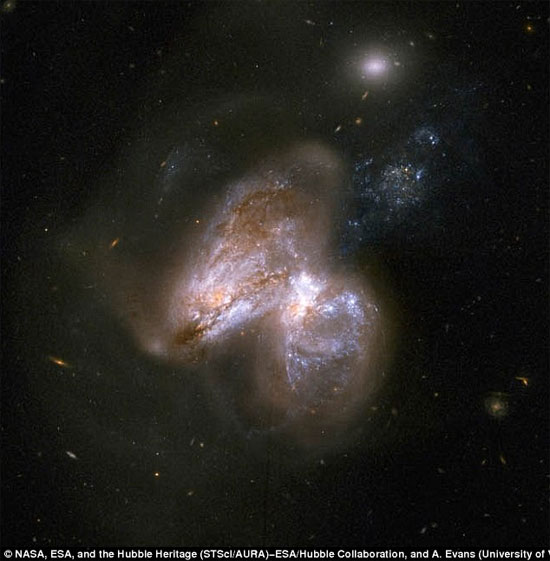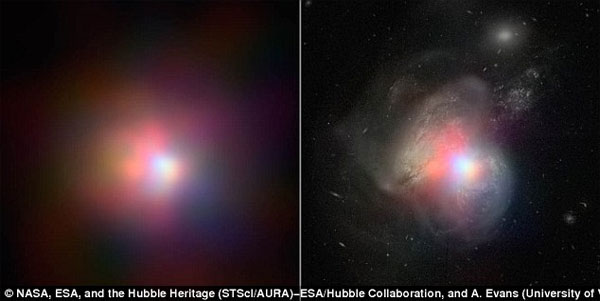Observing the scene where two galaxies collide creates black holes
Recently, NASA's NuSTAR nuclear spectrum telescope has detected two colliding galaxies. They are collectively known as the Arp 299 , located 134 million light-years from our Earth. This is a high-energy X-ray image that shows us what's going on.
The black hole located to the right of the pair is actively gorging on gas, while its partner is either active or hidden under gas and dust. In this image, X-rays with 4-6 volt kiloelectron energy are red, the 6-12 kiloelectron volts are green, and 12-25 kiloelectron volts are green.

The image of two galaxies colliding with each other, the gas of the left galaxy is being sucked into the black hole at the center of the galaxy to the right.
The NuSTAR telescope has discovered that the black hole to the right of the galaxy is trying to fill the galaxy's dust gas to the left. This finding could help scientists better understand how galaxies collide, as well as how black holes work at the center of each galaxy and the galaxy's subsequent growth. Previously, NASA also detected signs of a supermassive black hole in the Arp 299 based on low-energy X-ray traces.
However, scientists still do not understand the interaction between the two black holes of these two galaxies, because at the center of each galaxy is a giant black hole. Will both of these black holes attract dust from the remaining galaxy, or will the larger black hole swallow the remaining black hole? The current information is too little to find the answer.
The new X-ray data from NuSTAR - superimposed on a visible image of light from NASA's Hubble space telescope - shows the right black hole is, in fact, the hungry one.As it eat gas, the energy process near black hole thermal electrons and protons to hundreds of millions of degrees, creating an extremely hot plasma, or corona, which increases visible light to high-energy X-rays.

The light emitted from the right black hole shows that it is very active, the temperature can reach hundreds of millions of degrees Celsius.
NASA scientists have combined the Hubble telescope image to observe the light from these two galaxies. They discovered that the right black hole is very bright, meaning that its temperature is rising very high. Whereas the black hole on the left has no special signs, it is even covered by a giant gas dust moving toward the black hole on the right.
So scientists judged that only the right black hole is active and sucking the galaxy to the left on it. Scientists are also investigating what happens when these two galaxies approach each other, when two black holes will meet at the center.
It is hypothesized that the larger black hole will swallow the remaining black hole to create a new giant black hole. However, there is a theory that when two black holes approach each other, the tidal force at the crater can cause them to pop out and push both black holes away.
Scientists are continuing to observe this phenomenon to find answers. This is also the first time scientists can observe the phenomenon of two colliding galaxies thanks to a high-energy X-ray image. Previously observing black holes at the center of galaxies is very difficult, because low-energy X-ray images and light are covered by dense layers of gas.
- Three huge black holes are about to collide in the universe
- The galaxy has 3 black holes
- Milky Way between the black hole fin
- The supermassive black hole 'carnivores' from the inside
- Millions of black holes are hiding in our galaxy
- The three galaxies unite to
- Detected stunned the power of the supermassive black holes
- The moment the supermassive black hole swallowed
- For the first time, two black holes revolved around each other
- Black hole woke up after 30 years,
- Decoding mistakenly thought that the black hole of the universe is
- Galaxies reach adulthood in hydrogen pools
 Van Allen's belt and evidence that the Apollo 11 mission to the Moon was myth
Van Allen's belt and evidence that the Apollo 11 mission to the Moon was myth The levels of civilization in the universe (Kardashev scale)
The levels of civilization in the universe (Kardashev scale) Today Mars, the sun and the Earth are aligned
Today Mars, the sun and the Earth are aligned The Amazon owner announced a secret plan to build a space base for thousands of people
The Amazon owner announced a secret plan to build a space base for thousands of people